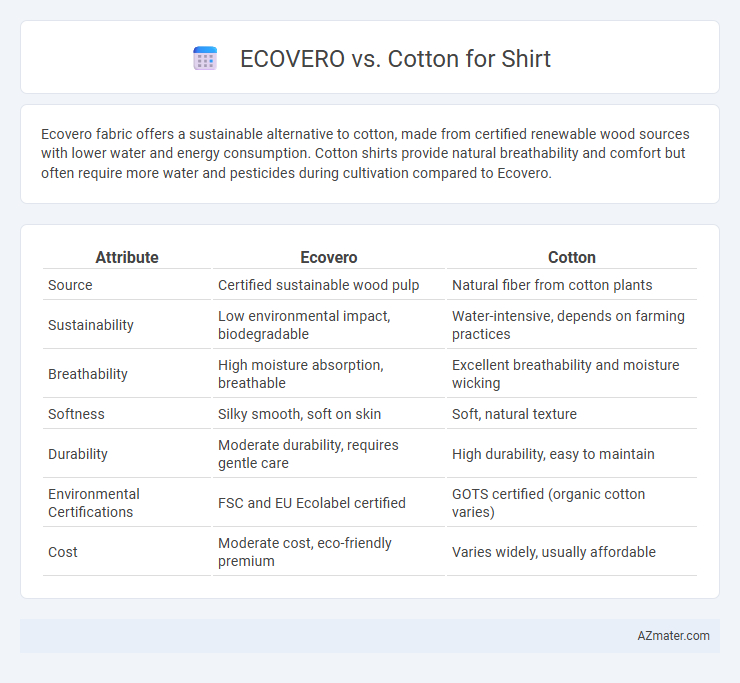Ecovero fabric offers a sustainable alternative to cotton, made from certified renewable wood sources with lower water and energy consumption. Cotton shirts provide natural breathability and comfort but often require more water and pesticides during cultivation compared to Ecovero.
Table of Comparison
| Attribute | Ecovero | Cotton |
|---|---|---|
| Source | Certified sustainable wood pulp | Natural fiber from cotton plants |
| Sustainability | Low environmental impact, biodegradable | Water-intensive, depends on farming practices |
| Breathability | High moisture absorption, breathable | Excellent breathability and moisture wicking |
| Softness | Silky smooth, soft on skin | Soft, natural texture |
| Durability | Moderate durability, requires gentle care | High durability, easy to maintain |
| Environmental Certifications | FSC and EU Ecolabel certified | GOTS certified (organic cotton varies) |
| Cost | Moderate cost, eco-friendly premium | Varies widely, usually affordable |
Introduction to Ecovero and Cotton Shirts
Ecovero is a sustainable fabric derived from certified renewable wood sources, produced through an eco-friendly process that reduces environmental impact, making it an innovative alternative to traditional textiles. Cotton shirts, made from natural cotton fibers, are widely valued for their breathability, softness, and comfort, but conventional cotton cultivation often involves intensive water use and pesticide application. Choosing between Ecovero and cotton for shirts involves balancing sustainability with the familiar comfort and durability associated with cotton fabrics.
Material Composition and Origin
Ecovero is a sustainable viscose fiber derived from certified renewable wood sources, produced through a closed-loop process that minimizes environmental impact. Cotton, traditionally cultivated from Gossypium plants, is a natural fiber valued for breathability and softness but often involves intensive water and pesticide use unless organic. The choice between Ecovero and cotton for shirts hinges on prioritizing eco-friendly manufacturing and renewable sourcing versus natural fiber comfort and familiarity.
Environmental Impact Comparison
Ecovero fibers, derived from sustainably sourced wood pulp, generate up to 50% less greenhouse gas emissions and 30% less water usage compared to conventional cotton cultivation. Cotton farming typically requires intensive irrigation, pesticides, and land use, contributing significantly to water depletion and soil degradation. Choosing Ecovero fabric for shirts supports reduced environmental impact through responsible forestry and lower resource consumption.
Softness and Comfort: Ecovero vs Cotton
Ecovero fabric offers superior softness and breathability compared to traditional cotton, making it ideal for comfortable shirts. Its smooth texture ensures a gentle feel on the skin while maintaining excellent moisture-wicking properties. Cotton, though soft and natural, may lack the same level of moisture management and durability found in Ecovero.
Breathability and Moisture Management
Ecovero fabric, derived from sustainably sourced wood pulp, offers excellent breathability and superior moisture-wicking properties compared to conventional cotton, making it ideal for active wear and hot climates. Cotton is naturally breathable and soft but tends to retain moisture longer, leading to discomfort and slower drying times. Ecovero's advanced moisture management ensures a cooler, drier feel throughout the day, enhancing overall comfort while maintaining eco-friendly credentials.
Durability and Longevity
Ecovero fabric, made from sustainably sourced wood pulp, offers enhanced durability and moisture-wicking properties compared to conventional cotton, making it resistant to shrinkage and wear over time. Cotton shirts provide natural breathability but tend to lose shape and strength faster due to fiber wear and environmental factors like UV exposure. Ecovero blends generally maintain color vibrancy and fabric integrity longer, increasing the shirt's lifespan and reducing the frequency of replacements.
Care and Maintenance Requirements
Ecovero shirts require gentle washing in cold water and air drying to maintain fiber integrity and prevent shrinking, while cotton shirts can generally withstand higher wash temperatures and machine drying without significant damage. Ecovero fabric resists fading and pilling better than cotton, reducing the need for frequent replacements. Cotton requires regular ironing due to wrinkles, whereas Ecovero typically wears smoother with less maintenance.
Style and Appearance Differences
Ecovero fibers offer a smooth, silky texture with a subtle sheen that enhances the elegance of shirts, making them ideal for contemporary and polished styles. Cotton provides a classic matte finish with a soft, breathable feel that suits casual and versatile designs. Shirts made from Ecovero tend to maintain a crisp appearance longer, while cotton emphasizes comfort and natural texture.
Cost and Market Availability
Ecovero fabric offers a sustainable alternative to cotton shirts with a higher price point due to its eco-friendly production process and certification standards, making it more expensive than conventional cotton. Market availability of Ecovero shirts is growing steadily in niche eco-conscious brands, though cotton remains vastly more accessible and widely distributed worldwide. Cotton shirts dominate mass markets due to lower raw material costs and established supply chains, ensuring affordability and extensive retailer presence compared to the emerging Ecovero textile.
Which is Better for Shirts: Ecovero or Cotton?
Ecovero fabric, derived from sustainable wood pulp, offers excellent breathability and moisture-wicking properties, making it an eco-friendly alternative to traditional cotton shirts. Cotton remains popular for its softness, durability, and natural feel but involves higher water consumption and environmental impact during cultivation. For sustainable fashion, Ecovero provides a better balance of comfort and environmental responsibility compared to conventional cotton.

Infographic: Ecovero vs Cotton for Shirt
 azmater.com
azmater.com